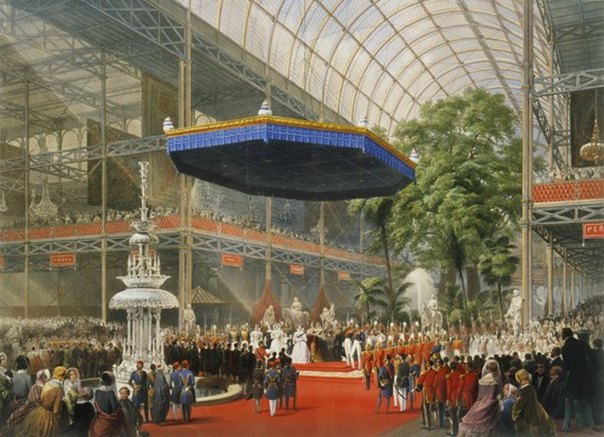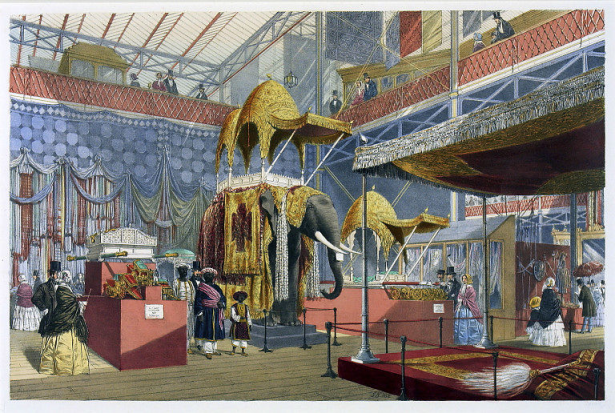On May 1, 1851, the brainchild of Prince Albert (Queen Victoria’s consort) came to fruition. He wanted to showcase Britain’s might and cutting-edge technology and include other nations as well. Therefore, a Royal Commission was issued for the first “world’s fair” called the Great Exhibition of the Works of Industry of All Nations.
The Great Exhibition was created by Henry Cole, George Wallis, Francis Henry, Charles Dilke and members of the Royal Society for the Encouragement of Arts, Manufactures, and Commerce, and, of course, Prince Albert.
Queen Victoria presided over the opening ceremonies and though The Times heralded the exhibition as the first time since the world’s creation that all peoples worked together, the English people initially responded with a resounding “Meh…” to the idea.

Queen Victoria opening the Great Exhibition inside the Crystal Palace accessed from Historic UK
Ultimately it caught on. By the time the exhibition ended in October, more than six million visitors had paid for entry. A casual walk through the exhibits might result in a sighting of Charles Dickens, Karl Marx, or Charlotte Bronté, as well as the Royal Family, who visited often.
The Exhibits
The exhibits were based, in typical Victorian style, on a thirty-part classification system with a focus on manufacturing. It started with raw materials and worked its way through to the final object. A large part of the exhibition focused on Britain’s empire and its manufacturing might. A lump of coal that weighed several tons, from Speedwell Colliery, was testament to the source of energy that powered the first industrial revolution. It also highlighted England’s coal industry.
However, other nations were included as well. Exhibitions included pottery, ironwork, perfume, pianos, in short, over 100,000 items over 10 miles. There was the hydraulic press that had been used to move a bridge, an adding machine, and the precursor to the fax machine. Also included were strange objects like an expanding hearse, folding pianos, and ink for the blind that rose up on paper, creating print readable by touch.
A fire-engine was sent from Canada, its panels painted with Canadian scenes. The Canadians also sent furs.
India sent a carved ivory throne, a pearl-covered coat, rubies, emeralds and the Koh-i-noor Diamond (“Mountain of Light”). They also sent an elaborate howdah (canopied saddle) for the rajah’s elephant. The stuffed elephant provided by an English museum of stuffed animals showcased the saddle.


Image 1: Indian exhibit, public domain Image 2: Crown Jewels of England with Koh-i-noor Diamond in center. Image accessed from Smithsonian Magazine at https://www.smithsonianmag.com/history/true-story-koh-i-noor-diamondand-why-british-wont-give-it-back-180964660/ on July 5, 2020.
Of course, the British Empire would not be returning the diamond; India would not get its freedom from Britain until 1947. Instead, they had it polished and set it in the crown jewels.
A huge eagle with outstretched wings, holding a star-spangled banner, the Colt’s repeating rifle and Cyrus McCormick’s reaping machine were sent by the U.S.
In one area, Egypt’s architecture with a complete recreation of the Avenue of the Lions and King Ramses court loomed over the visitors.

Egyptian Exhibit, public domain
There was also a recreated lead mine and the first recreation of dinosaurs and other extinct animals.
Replicas of statues from around the world could be seen, the most popular being the Greek Slave by Hiram Power. She had her own little red velvet tent since all she wore was a piece of chain.

The Greek Slave by Hiram Power. Accessed at https://www.nga.gov/collection/art-object-page.166484.html
France sent Sevres porcelain and silks from Lyons, furniture, tapestries, and enamels from Limoges together with the machinery used to produce these items.
Because of ice in the Baltic, the Russian exhibits arrived late. They sent porcelain and malachite vases and urns twice as tall as a man. They also sent Cossack armour.
Gold watches from Switzerland and a 50 kg. lump of gold from Chile were displayed.
All of these exhibits were housed inside the Crystal Palace.
The Crystal Palace

The Crystal Palace, exterior. Public domain.
A competition was held to see who could create the best design for the building to house the exhibition. The firm of Fox and Henderson won. Joseph Paxton was the architect and based his design on greenhouses he had built previously. Charles Fox was the structural engineer on the project and together they built the Crystal Palace with iron rods supporting the glass walls of the building.
The building was 1848 feet long by 454 feet wide, covering 19 acres. It held trees and large statues as well as the exhibitions.
But first, a visitor had to get to the Crystal Palace and in order to do so, one took a special train (the railway being another huge accomplishment of the era). The London and Brighton Railway provided various routes of entry. Tourists could buy their railway ticket which included the entry fee for the palace and grounds as well.
Once inside, the tourist would see the Palace’s famous fountain in the middle of the building. It was made of four tons of pink glass. It stood 27 feet high.

The Crystal Palace fountain, public domain.
Throughout the building a visitor could obtain refreshments by Messrs Schweppes, although no alcohol was sold. In addition, for the first time, one could obtain a private cubicle for “convenience” (bathroom) and it only cost one penny!
The building required over 1,000 iron columns to support 2,224 trellis girders. It was made up of 4,000 tons of iron, with 30 miles of guttering (a new invention). The transept arch was made of 16 huge semi-circular ribs made of laminated timber. In order to be cleaned (by machines), the flooring boards were set half an inch apart. Actually, though, the skirts of the women visitors took care of that quite well.
The palace was organized as series of courts depicting the history of art and architecture from ancient Egypt through the Renaissance, as well as exhibits from industry and the natural world. The building was so large, it easily held hundreds of statues and trees, as well as all of the exhibits.

The Crystal Palace from Encyclopedia Britannica assessed June 28, 2020
The original site of the palace was in Hyde Park and after the Great Exhibition it was dismantled, enlarged, and rebuilt in Sydenham Hill, one of the highest points in London. You can imagine how it looked, gleaming on a hill overlooking that bustling city.

Image from Hidden London: https://hidden-london.com/gazetteer/sydenham/ accessed July 5, 2020.
With the influx of tourists, hotels appeared and impressive homes were built nearby. The population in Sydenham Hill doubled every ten years for three decades due to housing for the employees of the palace.
Unfortunately, a fire destroyed most of the building in 1936. The rest of the building as torn down in 1941 so as to make less of a landmark for German bombers.
Because of its use of iron and glass, some architects hail the Crystal Palace as the first truly modern building. Historians often cite the fact that London’s building codes at the time did not normally allow for such prefabricated, imposing structures.
In either case, Paxton’s use of interchangeable, pre-built girders, columns, and other components of the building were novel and allowed the building to be deconstructed and then reconstructed (and enlarged upon) when moved to Sydenham Hill. It was the largest glass building of the nineteenth century, and the only free-standing iron-frame building of that century as well. Its design was a precursor to our skyscrapers.
Because of the amazing construction of the Crystal Palace, many exhibitions afterward were in glass buildings. New York was quick to create its own Crystal Palace in 1853, and Munich (1854) and Sydney (1879) among others followed suit.
Obviously, Joseph Paxton expanded the humble idea of a greenhouse and the many technical innovations of the Crystal Palace would be a legacy for architects to come.
Works Cited
Auerbach, Jeffrey A. The Great Exhibition of 1851: A Nation on Display. Yale University Press, 1999.
Chance, Tom. January 2018. The Crystal Palace’s Glass: a technical and social history. http://tomchance.org/wp-content/uploads/2018/03/Glazing_the_Crystal_Palace.pdf#:~:text=The%20Crystal%20Palace%20marked%20a%20number%20of%20great,to%20a%20different%20design%2C%20supplemented%20with%20new%20parts. Accessed July 7, 2020.
Encyclopedia Britannica at https://www.britannica.com/topic/Crystal-Palace-building-London. Accessed July 4, 2020.
Hidden London at https://hidden-london.com/gazetteer/sydenham/. Accessed July 6, 2020.
Historic UK at https://www.historic-uk.com/HistoryUK/HistoryofEngland/Great-Exhibition-of-1851/. Accessed July 6, 2020.
Phillips, Samuel. Guide to the Crystal Palace and Park: Facsimile edition of 1856 official guide. Euston Grove Press.
Picard, Liza. Oct 14 2009. “The Great Exhibition” at https://www.bl.uk/victorian-britain/articles/the-great-exhibition. Accessed July 7 2020.
